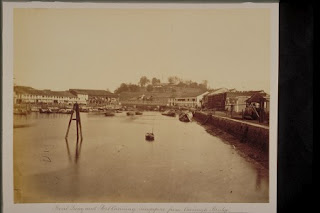In this picture, these are Chinese fans from the oldern China days. In the past, these fans had a variety of designs. On these 2 fans, they are painted with landscape scenes. This category of fans are landscape painting. These fan are not meant for fanning but rather they are a unique cultural conception of China. Compared to other countries, it is not representing a natural scene but rather endowing the cultural meaning in nature. I means a union between the person and nature. Harmony between humans and nature is an essential, basic element in landscape painting.
Compared to todays' fans, there is a vibrant range of colours added. These colours were not put in a structured manner but rather randomly. Some of todays' fans are not made only of wood and paper but could be made of feathers too. These days, fans were not semi-circle shaped but could be any shape like leaf-shape or circle shapes.
These are hand-painted porcelain with flowery patterns called the Bird-and-flower paintings. Flowers were an integral component of religious teaching and medicine. There are four types of flowers making up the "four gentlemen", these four flowers are plum, orchid, bamboo and chrysanthemum are the most welcomed paintings. And for a special type of flower, the "peony", it was the "king of flowers", symbolising wealth, good fortune and high status.
Todays' Bird-and-flower paintings are using freehand methods compared to the oldern times. The three categories of freehand painting is slightly freehand, greatly freehand and fine-brush with freehand styles. Nowadays, Bird-and-flower paintings are not only applicable to scrolls, manuscripts or porcelain but to anything as a form of design.
These scrolls are hanging from the wall and they are called Ancient Chinese Poem Calligraphy scrolls. Popular ancient Chinese proverbs on a scroll is a concise way to communicate to others the value of hard work, commitment, wise planning, and many more important morals. Chinese calligraphy artwork is an ancient and aesthetic discipline in China that often combines natural beauty with words of wisdom.
These day, hanging scrolls are much more colourful as the pictures had brighter colours. Hanging scrolls were not restricted to only calligraphy or paintings but they were also used for advertisements. Todays' scrolls could be coloured and drawn on silk and not just on paper.
.JPG)
.JPG)
.JPG)















